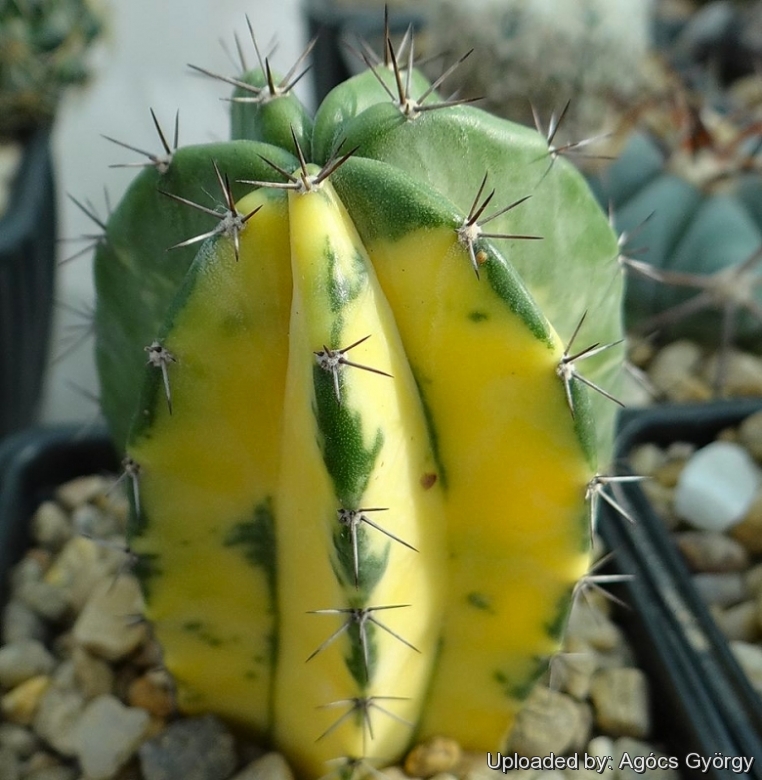= Stenocereus pruinosus f. variegata hort.
Accepted Scientific Name: Stenocereus pruinosus (Otto) Buxb.
Bot. Stud. Heft 12 (Entwickl. Trib. Pachycereae) 101 (1961).

Ritterocereus pruinosus f. variegata (Stenocereus pruinosus f. variegata) Photo by: Agócs György
Origin and Habitat: Garden origin (Nursery produced cultivar). The natural species comes from Mexico in the states of Oaxaca, Puebla, Veracruz, Guerrero and Chiapas.
Synonyms:
See all synonyms of Stenocereus pruinosus
back
Accepted name in llifle Database:Stenocereus pruinosus (Otto) Buxb.Bot. Stud. Heft 12 (Entwickl. Trib. Pachycereae) 101 (1961).Synonymy: 11
back
Description: The typical Stenocereus pruinosusSN|7951]]SN|7951]] is a large shrubby or tree-like columnar cactus to 4-5(-7) m tall, usually with one or more, definite trunk(s) from which little-branching stems arise from the base for a distinctive V-shape. The pruinose colour of young branches distinguishes it from the other arborescent species.
Variegated form: Variegated Stenocereus pruinosusSN|7951]]SN|7951]] are cultivated for their beautiful stem that have sectors, patches or stripes with two colours, yellow and grey-green. There are several forms of variegation. The extent and nature of the variegation can vary, and sometimes the plant will return to the green form. In others it is stable and does not change under normal conditions. Flowers are produced only on the crown of mature specimens. It is sought after and very priced by cactus impassioned. It is slower growing but can also get quite big with time making a spectacular specimen.
Subspecies, varieties, forms and cultivars of plants belonging to the Stenocereus pruinosus group
 Stenocereus pruinosus (Otto) Buxb.: is a large shrubby or tree-like columnar cactus to 4-5(-7) m tall, with one or more, trunks from which little-branching pruinose stems arise. Distribution: Mexico in the states of Oaxaca, Puebla, Veracruz, Guerrero and Chiapas.
Stenocereus pruinosus (Otto) Buxb.: is a large shrubby or tree-like columnar cactus to 4-5(-7) m tall, with one or more, trunks from which little-branching pruinose stems arise. Distribution: Mexico in the states of Oaxaca, Puebla, Veracruz, Guerrero and Chiapas. Stenocereus pruinosus f. variegata hort.: variegated form with sectors, patches or stripes with two colours, yellow and grey-green. There are several forms of variegation.
Stenocereus pruinosus f. variegata hort.: variegated form with sectors, patches or stripes with two colours, yellow and grey-green. There are several forms of variegation.
Bibliography: Major references and further lectures
1) Britton & Rose "The Cactaceae" volume 2, 1920
2) Edward Anderson “The Cactus family” Timber Press, Incorporated, 2001
3) James Cullen, Sabina G. Knees, H. Suzanne Cubey "The European Garden Flora Flowering Plants: A Manual for the Identification of Plants Cultivated in Europe, Both Out-of-Doors and Under Glass" Cambridge University Press, 11/Aug/2011
4) David R Hunt; Nigel P Taylor; Graham Charles; International Cactaceae Systematics Group. "The New Cactus Lexicon" dh books, 2006
5) Hecht. “BLV Handbuch der Kakteen” 287(1982) - as Polaskia chichipe.
6) Arreola, H. 2013. Stenocereus pruinosus. The IUCN Red List of Threatened Species. Version 2015.2. <www.iucnredlist.org>. Downloaded on 26 July 2015.
7) William H. Beezley “A Companion to Mexican History and Culture” John Wiley & Sons, 16 March 2011
Cultivation and Propagation: Variegated cacti are regarded as choice and difficult in cultivation, but despite that many of them are relatively easy to grow. But be aware that they cannot tolerate prolonged exposure to direct sun light (especially during the hottest summer days), so grow them in half-shade or under filtered sun. They are sometime seen as grafted plants, but some of this colourful plants (those with some chlorophyll) are able to grow on their own roots and are priced by collectors.
Soil: Use mineral well-permeable substratum with little organic matter (peat, humus).
Watering: Water sparingly from March till October, and keep perfectly dry in winter, at temperatures from 5 to 15 degrees centigrade. (In general these plants are more tender and cannot endure freezing temperatures). In the rest period no high atmospheric humidity!!
Propagation: By seeds, grafting or cutting. Because the variegation is due to the presence of two kinds of plant tissue, propagating the plant must be by a vegetative method of propagation that preserves both types of tissue in relation to each other. A most common way way to cultivate this partially de-coloured cultivars is to graft them onto another cactus which has chlorophyll and which will provide sugar to the mutant scion. The chlorophyll containing bottom part of the graft, called the stock, can be any number of different columnar cactus species.
Remarks: Seeds from variegated parents often give raise to some variegated seedlings too.










